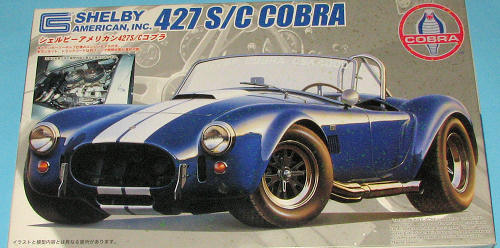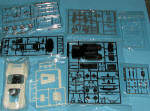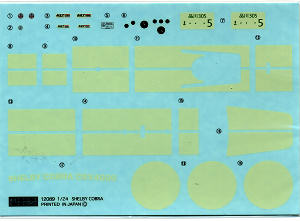
Fujimi 1/24 427 S/C Cobra
| KIT #: | 12089 |
| PRICE: | 2500 yen |
| DECALS: | Two options |
| REVIEWER: | Scott Van Aken |
| NOTES: |

| HISTORY |
Like many British specialist manufacturers, AC Cars had been using the smooth, refined Bristol straight-6 engine in its small-volume production, including its AC Ace 2-seater roadster. The engine was a pre-World War II design of BMW which by the 60s the company knew was considered dated. Bristol decided in 1961 to cease production of its engine and instead to use Chrysler 313cid (5.1 L) V8 engines. Although untrue, it is commonly believed that AC was left without a future source of power and that American ex-racing driver Carroll Shelby saved the company from bankruptcy. AC started using the 2.6 liter Ford Zephyr in all of its cars. In September 1961, Shelby airmailed AC a letter asking them if they would build him a car modified to accept a V8 engine. Shelby had previous experience with Anglo-American hybrids, having raced an Allard. He first went to Chevrolet to see if they would provide him with engines, but not wanting to add competition to the Corvette they said no. Ford however, wanted a car that could compete with the Corvette and they happened to have a brand new thin wall small block engine which could be used in this endeavor.
AC agreed, provided a suitable engine could be found. It was, in the form of, Ford's 260 in³ HiPo (4.2 L) engine - a new lightweight, thin-wall cast small-block V8 tuned for high performance. In January 1962 mechanics at AC Cars in Thames Ditton, Surrey, England fitted the prototype chassis CSX0001 with a 221ci Ford V8. After testing and modification, the engine and transmission was taken out and the chassis was air freighted to Caroll Shelby in Los Angeles on February 2, 1962. Here it was fitted with an engine and transmission in less than eight hours and taken out on test. Carroll Shelby claims the name "Cobra" came to him in a dream.
Production proved to be easy, since AC had already made most of the modifications needed for the small block V8 when they installed the 2.6 liter Ford Zephyr engine, including the extensive rework of the AC Ace's front end. The most important modification was the fitting of a stronger rear differential to handle the power of the Ford V8. A Salisbury 4HU unit with in-board disk brakes to reduce unsprung weight was chosen instead of the old ENV unit. It was the same unit used on the Jaguar E-Type. On the production version, the inboard brakes were moved outboard to reduce cost. The only modification of the front end of the first Cobra from that of the AC Ace 2.6 was the mounting of the steering box, which had to be moved outwardly to clear the wider V8 motor.
The first 75 Cobra Mark I (including the prototype) were fitted with the 260 engine (4.2 L). The remaining 51 Mark I model were fitted with a larger version of the Windsor Ford engine, the 289 in³ (4.7 L) V8. Toward the end of 1962, Alan Turner who was the chief engineer at AC completed a major design change of the car's front end and was able to fit it with Rack and pinion steering while still using transverse leaf springs suspension. The new car went into production in early 1963 and it became known as the Mark II. The steering rack was borrowed from the MGB while the new steering column came from the VW Beetle. About 528 Mark II Cobras were produced to the summer of 1965 (the last US bound Mark II was produced in November 1964).
By 1963 the leaf spring Cobra was losing its supremacy in racing, Shelby tried fitting a big Ford FE engine of 390 in³. Ken Miles drove and raced the FE powered Mark II car and said that the car was virtually undrivable, naming it 'The Turd'. A new chassis was developed and designated the Mark III.
The new car was designed in cooperation with Ford in Detroit. A whole new chassis was built which featured 4" main chassis tubes (instead of 3") and coil spring suspension all around. The new car also had wide fenders and a larger radiator opening. It was powered by the famed "side oiler" Ford 427 engine (7.0 L) developing 425 bhp (317 kW) and attaining a top speed of 163 mph (262 km/h) in the standard model and 485 bhp (362 kW) with a top speed of 180 mph (290 km/h) in the competition model. The production of the Cobra Mark III began on January 1 1965, two prototypes had been sent to the United States in October of 1964. Cars were sent to the US as unpainted rolling chassis, and they would be finished in Shelby's workshop. Although an impressive automobile, the car was a financial failure and did not sell well. To save cost, some AC Cobras MK III were fitted with Ford's 428 in³ (7.0 L) engine, a long stroke, smaller bore, lower cost engine, intended for road use rather than racing. It seems that a total of 300 mark III cars were sent to Shelby in the USA during the years 1965 and 1966, including the competition version. 27 small block narrow fender version which were referred to as the AC 289 were sold in Europe. Unfortunately, The MK III missed homologation for the 1965 racing season and was not raced by the Shelby team. However, it was raced successfully by many privateers and went on to win races all the way into the 70's. Interestingly, 31 unsold competition cars were detuned and made road worthy and called S/C for semi-competition (the subject of this kit). Today, these are the rarest and the most valuable models and can sell for in excess of a million and a half Dollars.
AC Cobras had an extensive racing career. Shelby wanted it to be a "Corvette-Beater" and at nearly 500 lb (227 kg) less than the Chevrolet Corvette, the lightweight car did just that. The Cobra was perhaps too successful as a performance car and reputedly contributed to the implementation of national speed limits in the United Kingdom. An AC Cobra Coupe was calculated to have done 185 mph (298 km/h) on the M1 motorway in 1964, driven by Jack Sears and Peter Bolton during shakedown tests prior to that year's Le Mans 24h race. However, government officials have cited the increasing accident death rate in the early 1960s as the principal motivation, the exploits of the AC Cars team just highlighting the potential risk.
Although extremely successful in racing, The AC Cobra was a financial failure, which led Carroll Shelby to discontinue importing cars from England in 1967. AC Cars kept producing the coil springs AC Roadster with narrow fenders, a small block Ford 289 and called the car the AC 289, it was built and sold in Europe until 1969. AC also produced the AC Frua until 1973. The AC Frua was built on a stretched Cobra 427 MK III coil spring chassis using a very handsome steel body designed and built by Pietro Frua. With the demise of the Frua, AC went on building lesser cars and fell into bankruptcy in the late 1970s'. The company's tooling and eventually the right to use the name, were acquired by Autocraft, a Cobra part reseller and replica car manufacturer owned by Brian A. Angliss. Autocraft was manufacturing an AC 289 continuation car called the Mark IV. Carroll Shelby eventually filed suit against AC Cars and Brian A. Angliss, in U.S. District Court in Los Angeles. The ensuing settlement resulted in Shelby and AC Cars/Angliss releasing a joint press release whereby AC/Angliss acknowledged that Carroll Shelby was (and is) the manufacturer of record of all the 1960s AC Cobra automobiles in the United States. Despite this there is no doubt that every Cobra made in the '60s was manufactured by AC Cars in England. Shelby merely imported and modified the cars into their final form. Carroll Shelby's company Shelby Automobiles, Inc. continues to manufacture the Shelby Cobra 289, FIA 289 and 427 S/C vehicles at its facility in Las Vegas, Nevada. These cars retain the style and appearance of their original 1960s ancestors, but are fitted with modern amenities. In 2006 Carol Shelby's own Shelby Cobra sold at an auction in Arizona for £2.8million.
| THE KIT |
 This
2002 release is molded in a variety of colors, including white for the body
components, black for the chassis, and grey for the motor bits. The chrome is
very nicely done and will, for most modelers, have to be stripped down and
repainted when the seam lines are removed. Clear pieces are also provided.
Fujimi doesn't spare the clear bags either so you are assured of getting
scratch-free parts.
This
2002 release is molded in a variety of colors, including white for the body
components, black for the chassis, and grey for the motor bits. The chrome is
very nicely done and will, for most modelers, have to be stripped down and
repainted when the seam lines are removed. Clear pieces are also provided.
Fujimi doesn't spare the clear bags either so you are assured of getting
scratch-free parts.
This kit, as well as most Fujimi car kits, is superbly molded with nary a trace of sink areas and only a few ejector pin marks. It is obvious when looking at the sprues that there are optional bits, but this being the street car, those 'racing' bits (basically four dual downdraft Weber carburetors and intake manifold as well as a wider roll bar), are marked on the instructions as not used.
There is a full engine with dual four barrel Holley carburetors as the power plant. There is a complete suspension to attach to the chassis and this includes workable steering (assuming you don't break anything during construction). The vinyl tires look very good as do the chrome wheels, that are held onto the axle stubs by polycaps. This is a good move as it means one can install them to check the 'squareness' of the chassis and then pull them off until after painting and final assembly.
 Interior
is complete, but like the real car, rather Spartan. No A/C, no DVD player, no
heated seats, no digital dash or cup holder on this one. It also appears that
one can have the hood and trunk posed open if one wishes.
Interior
is complete, but like the real car, rather Spartan. No A/C, no DVD player, no
heated seats, no digital dash or cup holder on this one. It also appears that
one can have the hood and trunk posed open if one wishes.
Instructions are very well done with clear assembly steps and color information provided in Gunze references. For markings there is a sheet of decals that provides white stripes for the blue box art car. Another option is one that is a solid color without stripes. The decals are old school Japanese where the white is a bit off, though Fujimi decals will stick well. One could do a racing version if one so wishes as there are racing roundels provided on the sheet.
| CONCLUSIONS |
Another well done American 'supercar' and a model that will look just mahvelous on your display shelf.
| REFERENCES |
August 2008
Got this beauty at a vendor last year. Nice, eh?
If you would like your product reviewed fairly and quickly, please contact me or see other details in the Note to Contributors.